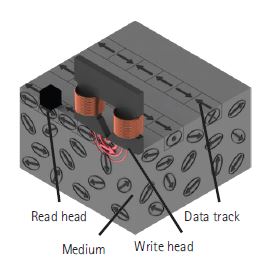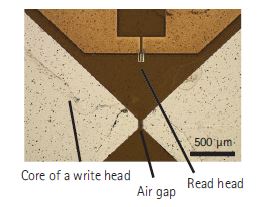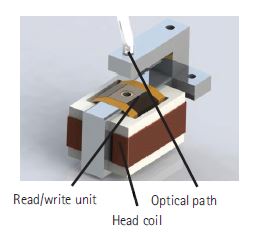Magnetic data storage on a technical surface
The subproject L3 developes a method for magnetic storage of manufacture and user data on a surface of gentelligent components (Figure 1). Individual and critical product information can be intrinsically stored on a component. This will help the manufacturer as well as the user to identify and apply a component accordingly. During usage, a component life expectancy, its current status and loading experience can be updated back to the component, and thus maintenance can be effectively planed. At the end of its lifecycle, stored safety guidelines will help the user in disposal of a component.



In the previous grant periods, rigid write heads made of MnZn ferrite to form the magnetic core with a 100 μm air gap were developed for inductive writing. While the first head generation has a 700 μm track width, the second head generation achieves its fabrication limit at 350 μm. In a close cooperation with the sub-project E2 and E3, various magnetic storage media were developed, e.g. sintered Mg with γ-Fe2O3 hard magnetic particles and magnetic MgCo4-alloy. A component can equipped with or even made of the media material. Readout of stored information is done by applying a GMR sensor as a reading element and a specially developed algorithm capable of detecting data stored in a medium with inhomogeneous particle dispersion. The attainable data density, limited by the size of the applied GMR sensor, is 100 bit/cm2. In a typical application scenario, a flying height of the head in a range of tens of μm and a low vibration environment are decisive parameters.
In the current grant period, the focus is shifted to system integration and usability. A direct integration of a read head into the write head is proposed in order to increase data density. To cope with head damage that may occur in an environment vibrations, it is necessary to make the head flexible and thus immune to mechanical shocks. Polymers can be used as flexible substrates on which functional parts of the heads are fabricated. Thin film processes are employed for fabrication of functional parts of a read/write head (Figure 2). Because of its excellent material properties and compatibility to fabrication processes, Kapton® polyimide film is selected as a flexible subtrate. Pretreatment of the Kapton® film as well as techniques for bonding and debonding the film from a carrier during fabrication are developed. The flexible read/write head has a 50 μm air gap with a width of 100 μm.



To increase data reliabilty against magnetic stray fields and high temperature, the use of new storage media with higher coercivity is necessary. This in turn requires a higher write energy. Heat-assisted magnetic recording, a novel technology that uses thermal energy to reduce magnetic field intensity required for writing a medium, is a promissing solution and is currently pursued by the subproject L3 (Figure 3).





